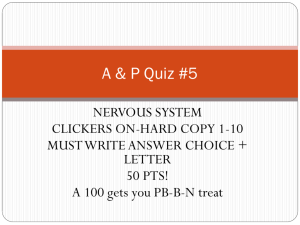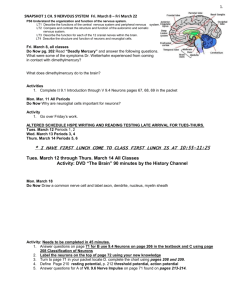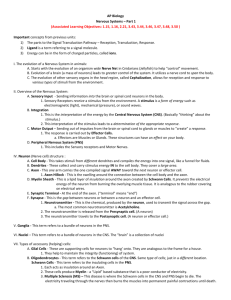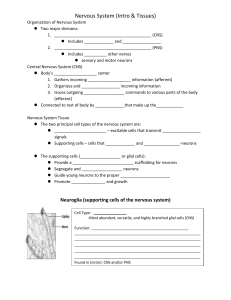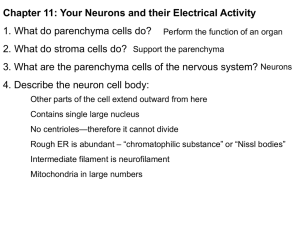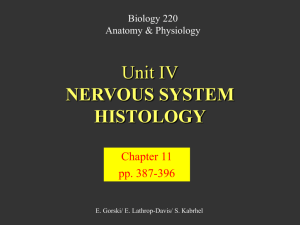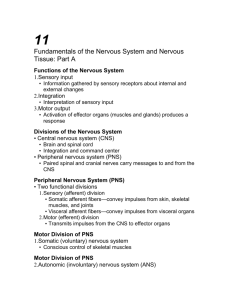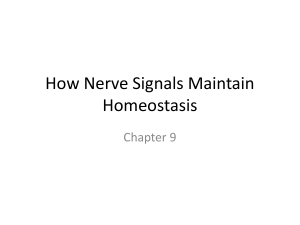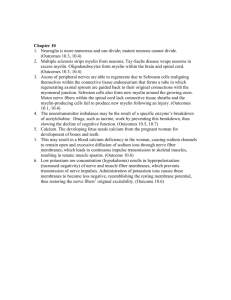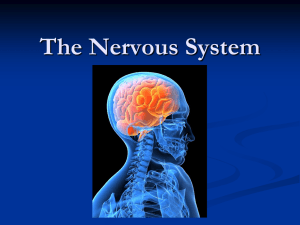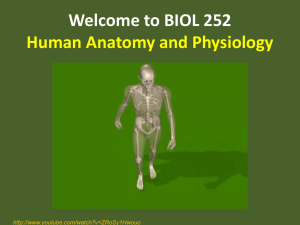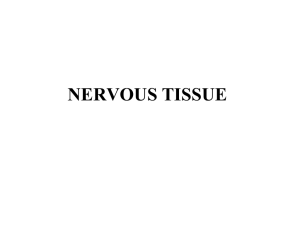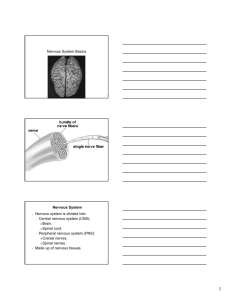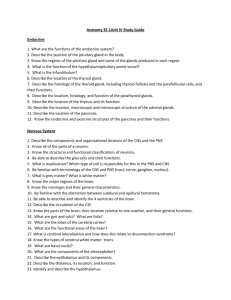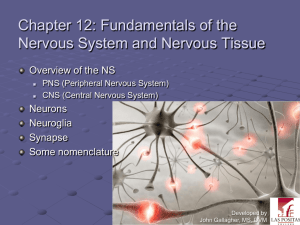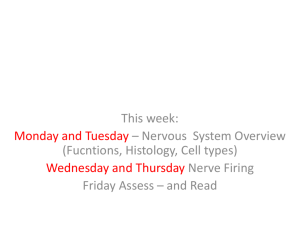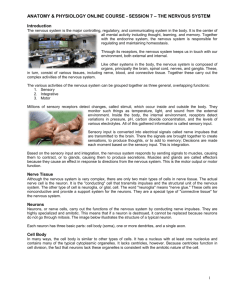Overview of the Nervous System Nervous System Functions
advertisement
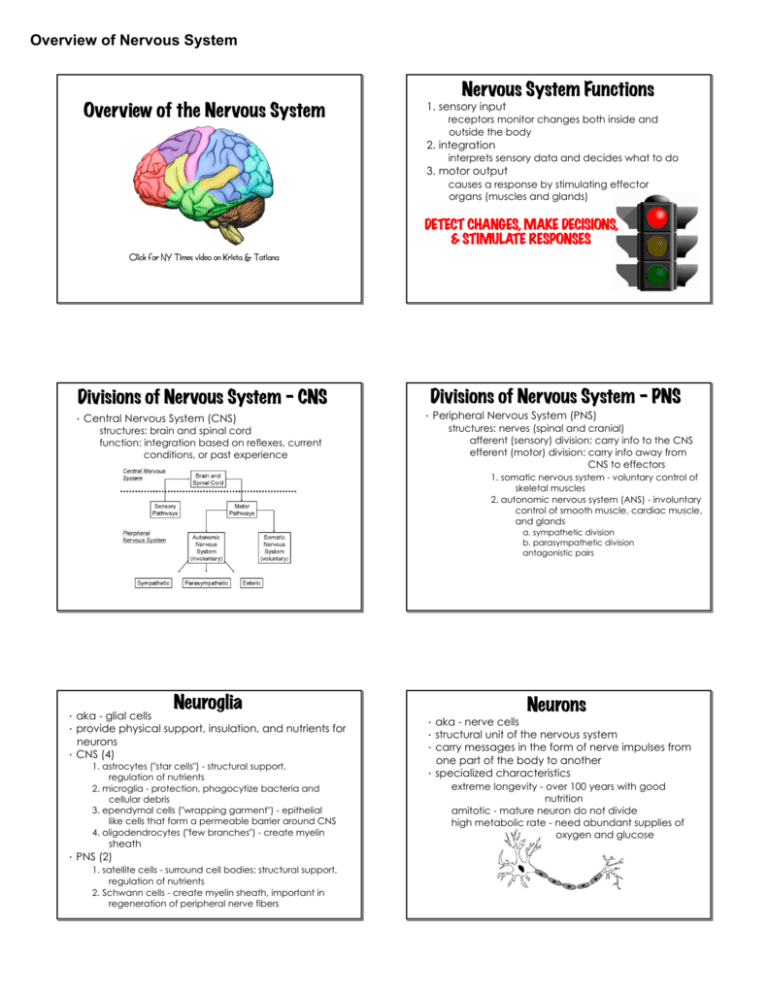
Overview of Nervous System Nervous System Functions Overview of the Nervous System 1. sensory input receptors monitor changes both inside and outside the body 2. integration interprets sensory data and decides what to do 3. motor output causes a response by stimulating effector organs (muscles and glands) DETECT CHANGES, MAKE DECISIONS, & STIMULATE RESPONSES Click for NY Times video on Krista & Tatiana Divisions of Nervous System - CNS · Central Nervous System (CNS) structures: brain and spinal cord function: integration based on reflexes, current conditions, or past experience Divisions of Nervous System - PNS · Peripheral Nervous System (PNS) structures: nerves (spinal and cranial) afferent (sensory) division: carry info to the CNS efferent (motor) division: carry info away from CNS to effectors 1. somatic nervous system - voluntary control of skeletal muscles 2. autonomic nervous system (ANS) - involuntary control of smooth muscle, cardiac muscle, and glands a. sympathetic division b. parasympathetic division antagonistic pairs Neuroglia · aka - glial cells · provide physical support, insulation, and nutrients for neurons · CNS (4) 1. astrocytes ("star cells") - structural support, regulation of nutrients 2. microglia - protection, phagocytize bacteria and cellular debris 3. ependymal cells ("wrapping garment") - epithelial like cells that form a permeable barrier around CNS 4. oligodendrocytes ("few branches") - create myelin sheath · PNS (2) 1. satellite cells - surround cell bodies; structural support, regulation of nutrients 2. Schwann cells - create myelin sheath, important in regeneration of peripheral nerve fibers Neurons · aka - nerve cells · structural unit of the nervous system · carry messages in the form of nerve impulses from one part of the body to another · specialized characteristics extreme longevity - over 100 years with good nutrition amitotic - mature neuron do not divide high metabolic rate - need abundant supplies of oxygen and glucose Overview of Nervous System Neuron Structure · vary in size and shape · 2 basic structural components 1. cell body 2. processes dendrites - convey incoming messages toward the cell body axon - convey outgoing messages away from cell body Processes · dendrites - short and highly branched · axon - nerve fiber axon hillock ("little hill") - start of axon terminal branches - branching ends of an axon axon terminals, synaptic knobs, or boutons knoblike ends of terminal branches axolemma - plasma membrane; site of nerve impulse conduction do not contain Nissl bodies or a Golgi apparatus Structural Classification of Neurons · multipolar - 3 or more processes (1 axon + many dendrites) most common type in humans (99%) · bipolar - two processes (1 axon + 1 dendrite) · unipolar - 1 process that divides into two branches Cell Bodies · nucleus and nucleolus centrally located · free ribosomes, rough ER (called Nissl bodies or chromatophilic substance), and Golgi apparatus very active and best developed in body · mitochondria, neurofibrils (protein filaments) scattered throughout · most cell bodies located in CNS where they are protected by the skull and vertebra nuclei - clusters of cell bodies in CNS ganglia - clusters of cell bodies in PNS Myelin · whitish, fatty and segmented · protects and electrically insulates fibers, and increases speed of nerve impulse transmission · myelinated vs. unmyelinated myelinated - fast transmission unmyelinated - slow transmission · Schwann cells - create myelin in PNS · neurilemma - outer portion of Schwann cells · nodes of Ranvier - narrow gaps between Schwann cells · white matter - dense collections of myelinated fibers · gray matter - nerve cell bodies and unmyelinated fibers Functional Classifications of Neurons · sensory (afferent) neurons - carry nerve impulses from sensory receptors into brain or spinal cord most are unipolar, very few bipolar (retina) · motor (efferent) neurons - carry nerve impulses out of brain or spinal cord to effectors multipolar · interneurons (association neurons) - link sensory and motor neurons, shuttle signals through CNS pathways where integration occurs multipolar 99% of neurons of the body confined within CNS

